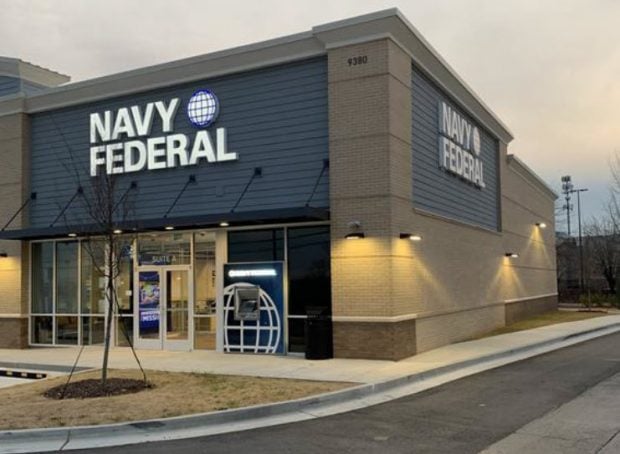 Navy Federal branch in Douglasville, Ga.
Navy Federal branch in Douglasville, Ga.
Navy Federal Credit Union's mobile banking channel managed two billion sessions in 2022. That mind-boggling number will only continue to grow along with the expanding service expectations of Navy Federal's 12.3 million members.
The evolution of Navy Federal's mission to always put members first, which has fueled its strong growth over the years, making it the world's largest credit union, is entering a new phase of that mission with the recent launch of the Member Strategy Office.
Recommended For You
Annie Sebastian, who joined the $156 billion Navy Federal in Vienna, Va., in 2008 and moved up the leadership ranks, holding key executive positions in the fields of digital, membership, marketing research and strategy, is leading a new initiative that will centralize certain internal groups to leverage their capabilities to advance Navy Federal's mission amid today's fast-paced competition from financial technology firms.
In a CU Times interview, Sebastian, as Navy Federal's chief member strategy officer, shared her insights about the Member Strategy Office and how it is expected to elevate Navy Federal's mission.
CU Times: What led Navy Federal to establish the Member Strategy Office?
Sebastian: Our members have always been our mission and how we deliver on that mission has continued to evolve, but it's no longer enough to just have great products and services. The competitive environment is changing at such a rate that we recognized the need to align and innovate a little bit differently. Everyone in the credit union plays a role in serving our members, but we didn't have a centralized way to leverage and align some of the capabilities we've built to better know our members. And so, we established the Member Strategy Office as part of our strategic commitment to member centricity.
CU Times: How does Navy Federal currently try to understand what members want insofar as financial services and products?
Sebastian: We have a robust research group that does surveys, focus groups and individual conversations with members. We have a phenomenal user experience design group that does prototyping and understands what types of experiences work well for our members. And we have a strategy group that really gets into the hearts and minds of members. All of those groups will be combined together into one group within the new Member Strategy Office as well as our analytics. So understanding the voice of the member using data, business intelligence and better analytics of what's happening within our membership from a segment view will tell us what's most important to work on. By combining these groups all into the new Member Strategy Office, we're elevating them to bring enterprise assets to work across our products and channels that will enable them to be smarter in understanding what are the needs of our members so that we can innovate and not just in the product space, but really in the service space.
CU Times: What does Navy Federal see changing within its membership and in the marketplace, and how is that affecting the credit union's perspective in serving its members?
Sebastian: The mission of credit unions being member focused is always a competitive advantage. But with a lot of fintechs coming out and focusing on very niche needs of members, and consumers more broadly, we're seeing different rises of Buy Now, Pay Later or Cash App with how members are moving money. So, I think the niche players are really innovating on service, which has historically been one of our competitive advantages. We want to focus more not just on having great products and great rates, which we've always had, but especially on service. Our branches and our contact center are critical ways in which we do that. And we have amazing award-winning digital channels, but that type of connection to the member and that innovation and service across all of our touchpoints is something that we really want to focus on.
CU Times: Do you think Navy Federal is going to compete with fintechs in those niche markets?
Sebastian: I don't know about competing against them in niche markets. We already have a very defined field of membership, which we're really proud to serve. We'll continue to ideate on what does a new recruit, the active duty military service member need, or what does someone who recently transitioned out of the military need, and think in terms of segments and niche opportunities for them. There are lots of micro segments that we need to understand deeply and to continue to win. And so that's part of what the Member Strategy Office will do by bringing those principles of user experience design, UX research strategies, surveys, focus groups, plus really advanced analytics to get into the hearts and the minds and the behaviors of our members to understand them. Of course, the goal is that one-to-one type personalization, not even segment based, but how do we build those capabilities to understand what is it that one member needs that's different than what another member needs.
 Annie Sebastian
Annie Sebastian CU Times: What portion of your members are downloading fintech apps?
Sebastian: We certainly have a portion of members who are connected to fintechs, and it's actually a metric that we track. And as part of our open banking initiative, we're going to get smarter because there's individual use cases, like you're getting a mortgage and they use Plaid to connect to that. But there's more disruptive use cases like Acorn or a Robinhood that are competitors to our business. Those different use cases and how do we ensure that we can provide that full solution to our members will be very important too.
CU Times: How is Navy Federal's large branch network going to be affected by the Member Strategy Office?
Sebastian: We are committed to building branches, and we know that the majority of our members actually live within a 30-mile radius of an NFCU branch. That connection to a human and service is really important. So all of our channels are fully integrated into our Member Strategy Office, but digital will obviously be a large component. We had two billion sessions on our mobile platform just last year. But we've also been adding branches. We have 355 branches now worldwide. And I think we're very unique in that our contact center is 24/7/365 with U.S. based reps, so we are committed to service in every way. One of our philosophies is that you will always have a path to a human. We recognize the importance of that human connection, but with so much interaction happening digitally, we have to innovate in the digital space for service and connection as well, and [consider] how we humanize our digital channels.
CU Times: Do you have any concerns there are going to be obstacles and challenges to getting everyone on board with this new initiative?
Sebastian: One of the things that we did that was really smart in setting this up is we put together an executive working group to define the opportunity and to help co-create what this looks like. So from before it was built, I had executive buy-in from the front office and my peers that this is the right thing to do and that it will help us. Will there be bumps along the way? Sure. But everybody understands the power of what this could bring, so I feel really confident that we've got the organizational buy-in to achieve it.
CU Times: Have you set a timeline as to when the Member Strategy Office will be fully operational?
Sebastian: It's certainly not going to be a quick build. The great news is some of these capabilities already exist, so we're leveraging them today and we do expect some key insights and quick wins. But it's also a new way of working, and that takes time. Getting the organization aligned and figuring out our new processes is something that's going to take time. But I think we'll be able to get insights on what to do sooner than later.
© 2025 ALM Global, LLC, All Rights Reserved. Request academic re-use from www.copyright.com. All other uses, submit a request to [email protected]. For more information visit Asset & Logo Licensing.






